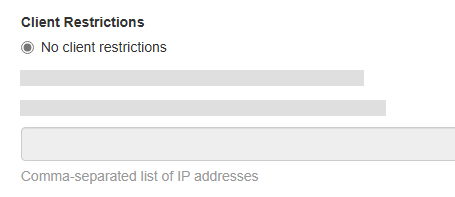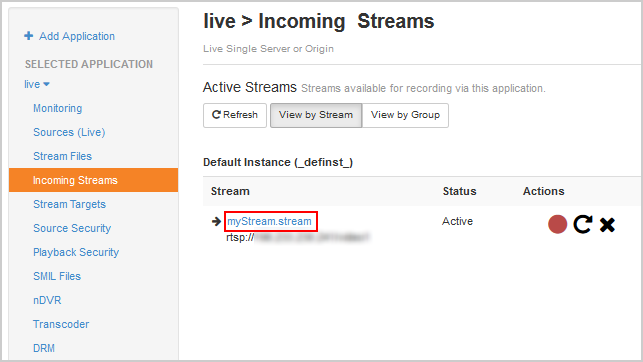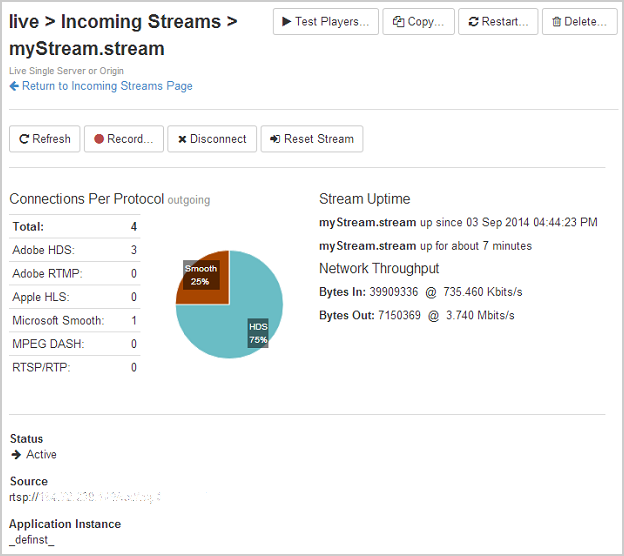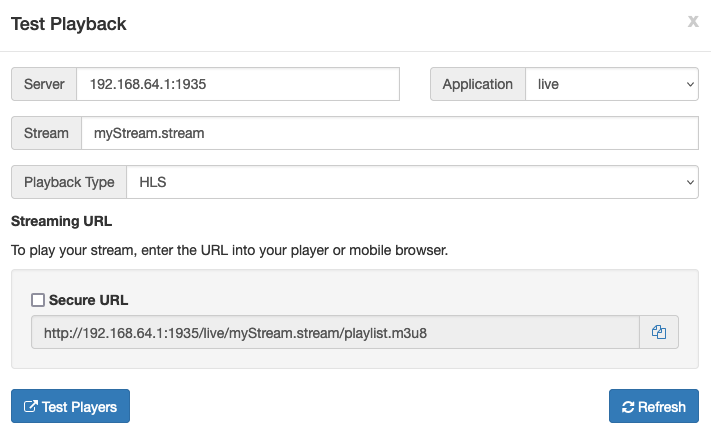Re-stream an Adobe Media Server stream that supports H.264 and AAC through the Wowza Streaming Engine™ media server software MediaCaster feature.
Before you start
You should complete the following tasks:
- Create a live application according to Create applications.
1. Configure playback
Before connecting a live source and publishing a live stream, complete the following steps to configure playback support for your application.
- Click the Applications tab at the top of the page and then select your application in the contents panel.
- Click the Setup tab on your application's page and then click Edit.
- Under Playback Types, select any streaming protocols you need to support for playing streams sent to this application. The playback types enable transmuxing a source stream into MPEG-DASH, HLS, RTMP, and RTSP/RTP.
- Click Save.
- In the application's contents panel, click Playback Security, and then click Edit. For more information about Playback Security options, see Playback security options.

- Under Client restrictions, select No client restrictions to allow players to connect from any IP address.

- Click Save and then restart the application.
2. Enable re-streaming an Adobe Media Server stream
Complete the following steps to configure your live application for re-streaming an Adobe Media Server stream:
- Open the Application.xml file for your live application ([install-dir]/conf/[application-name]).
- Add the callFCSubscribe property set to true within the MediaCaster/Properties container element:
<Property> <Name>callFCSubscribe</Name> <Value>true</Value> <Type>Boolean</Type> </Property>
3. Connect to a source stream
Next, create a .stream file in Wowza Streaming Engine Manager to publish your stream to Wowza Streaming Engine using the MediaCaster (re-streaming) feature.
- Create the .stream file:
- In the Server contents panel, click Stream Files, and then click Add Stream File.

Note: You can also start the procedure to create a .stream file in the Applications contents panel for an application.
- In the Add Stream File dialog box, enter a name for the new stream file and enter a Stream URI. The URI should be the full RTMP URL of the stream that you want to re-stream, for example, rtmp://cp12345.live.edgefcs.net/live/myStream@2440.
- Click Add.
- In the Server contents panel, click Stream Files, and then click Add Stream File.
- Start the stream:
- In the Server contents panel, click Stream Files, and then click the Connect icon for the stream file you created in step 1.
- In the Connect a Stream File dialog box, select your application in Application Name and liverepeater in MediaCaster Type, and then click OK.
- In the Server contents panel, click Stream Files, and then click the Connect icon for the stream file you created in step 1.
4. Verify the connection
To verify that Wowza Streaming Engine is receiving the published stream, complete the following steps in Wowza Streaming Engine Manager.
- Click Incoming Streams in the contents panel for your live application. You should see your stream listed with Active for the status.

- Click the stream name to see the uptime, network throughput, and other information about the published stream.

5. Test playback
- In Wowza Streaming Engine Manager, in the contents panel for your application, click Stream Files.
- In the Stream Files list, click the name of your stream file.
- From your stream file's page, click Test Playback.
- Review and, if needed, edit the following information in the Test Playback window for your stream:
- Server – The IP address or domain name of the server and the streaming port ([address]:[port]).

Note: The stream name should include the .stream file extension.
- (Optional) In the Streaming URLs section, select Secure URL for the streaming protocol you want to use to test playback if you have configured SSL/TLS for streaming over https, rtmps, or rtsps.
- Click the Copy icon for the streaming protocol you want to use to test playback.
- Paste the playback URL into your player or a mobile browser depending on the protocol. Alternatively, you can use the Wowza Video Test Players webpage. For more information about playback URLs, see About playing Wowza Streaming Engine streams.











